Progress on plastic reduction in packaging released by 16 fast-moving consumer goods brands including nestlé, pepsi, unilever, coca-cola, and mars
 On November 4, 2025, the Global Commitment 2025 Progress Report, jointly compiled by the Ellen MacArthur Foundation and the United Nations Environment Programme, was officially released, showcasing the substantial progress made by companies that signed the Global Commitment in promoting the transformation towards a circular economy for plastics.
On November 4, 2025, the Global Commitment 2025 Progress Report, jointly compiled by the Ellen MacArthur Foundation and the United Nations Environment Programme, was officially released, showcasing the substantial progress made by companies that signed the Global Commitment in promoting the transformation towards a circular economy for plastics.
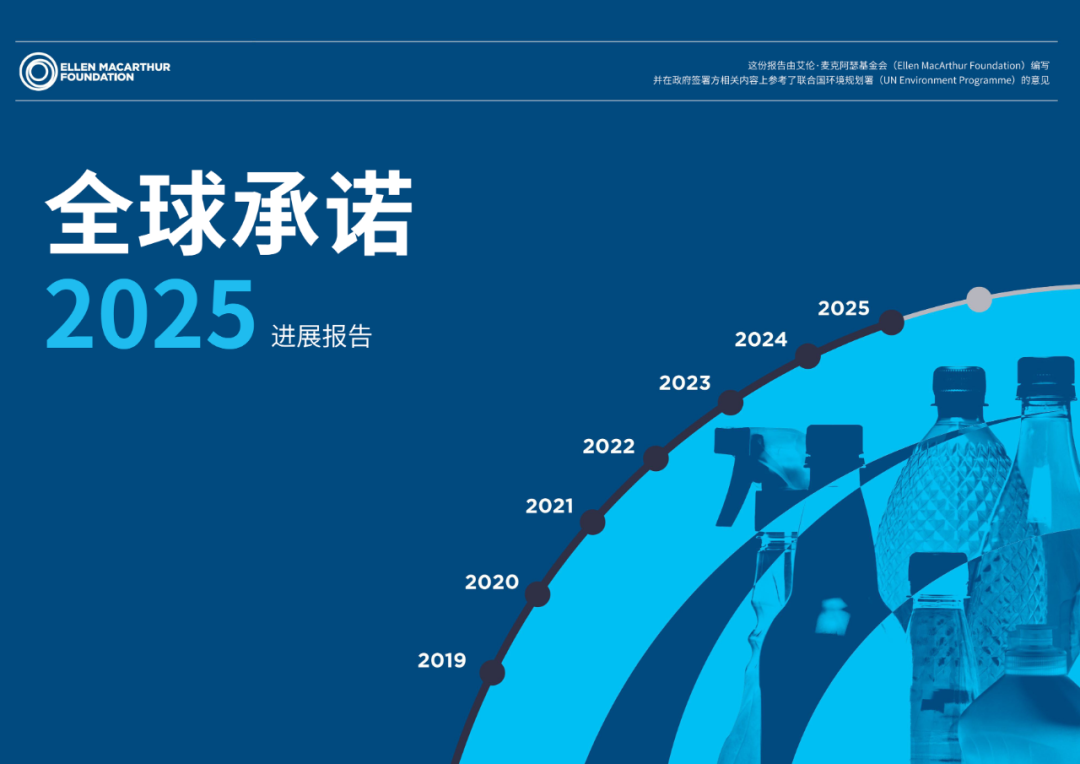
— 1—
Since its launch in 2018, the Global Commitment has been joined by over 1,200 organizations worldwide, including companies representing 20% of the global plastic packaging volume and more than 50 governments. The initiative aims to drive the transition of plastic packaging towards a circular economy model and has set clear targets for 2025.
The main trends of 2024 show:
The signatories have successfully reversed the growth curve of virgin plastic usage in packaging. Despite the global market's virgin plastic usage increasing by 13% compared to 2018, the brand and retail signatories have, on average, reduced their usage by 6%.
The signatory will triple the use of post-consumer recycled plastics.
The signatories have eliminated over 775,000 tonnes of packaging typically considered problematic or unnecessary, equivalent to tens of billions of items.
Systemic barriers such as large-scale reuse patterns still constrain further progress.
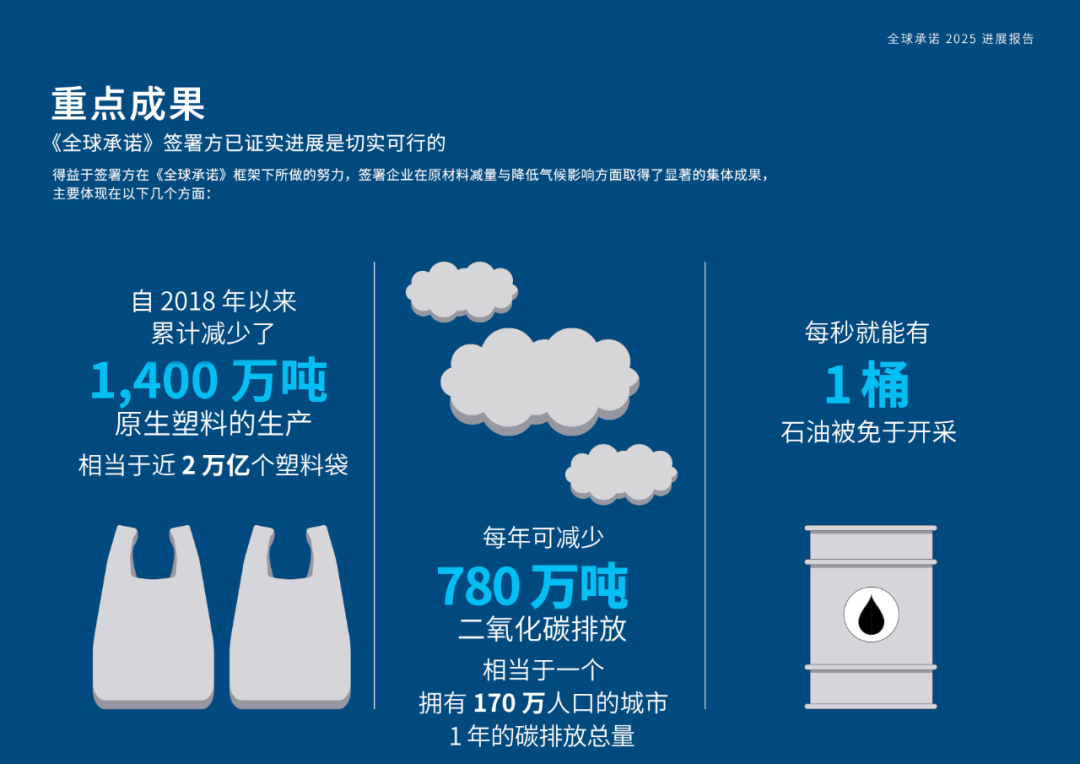
— 2—
The signatory's performance outperforms the market.
The latest data shows thatSetting ambitious goals can accelerate action. Figure 1Enterprises committed to achieving ambitious goals have outperformed others in the global plastic packaging market. This group has tripled the use of recycled materials in just six years and eliminated tens of billions of problematic products. Through these initiatives, these industry leaders have not only shaped the industry landscape but also gained a competitive edge before regulatory policies are implemented. The remaining 80% of the market also needs to work together to build a circular economy.
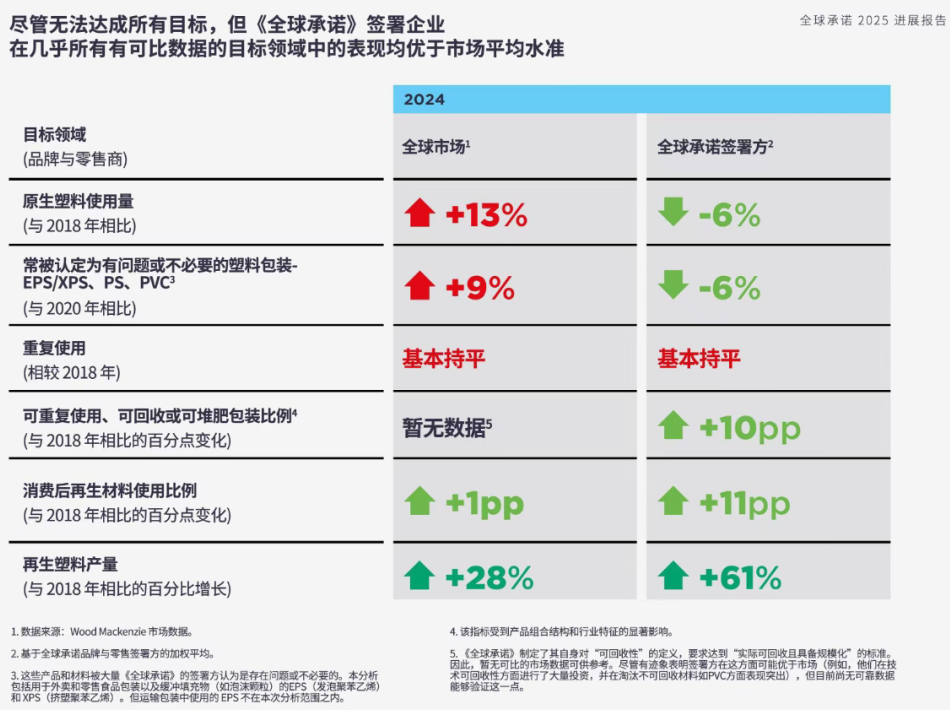
Figure 1
— 3—
Key Progress Indicators
According to the annual progress overview data, compared to 2023, the use of virgin plastics decreased by 1.5%; the proportion of post-consumer recycled content (PCR) increased by 2 percentage points; the proportion of recyclable packaging grew by 2 percentage points; the proportion of packaging designed for recyclability also increased by 2 percentage points; while the proportion of reusable packaging remained unchanged.

1 Reduce the use of virgin plastic in packaging.
Company Progress:Between 2023 and 2024, brands and retail companies reduced the use of virgin plastic by 1.5% through increased use of post-consumer recycled (PCR) plastics. This marks the fourth consecutive year of reduction, indicating that these companies have surpassed the peak of virgin plastic consumption.
Government Progress:Although not a direct target, the government continues to create favorable conditions for recycled plastics/reuse/phasing out packaging through policy incentives.
2 Increase the target proportion of post-consumer recycled plastic in all used plastic packaging.
Business Progress:Despite many signatories pointing out the challenging market environment, the proportion of PCR usage has continued to steadily increase (from 14% in 2024 to 16%). Compared to 2018, the PCR usage among brand and retail signatories has grown more than threefold (from 5% to 16%). Recycling companies have continued to expand the scale of plastic recycling, increasing by 6% compared to 2023, with the production of recycled materials this year nearing 2 million tons.
Government Progress:Currently, over 40% of government signatories have revised or established minimum PCR content standards for packaging. For example, Chile mandates a minimum PCR content of 15% for beverage bottles, and the UK imposes an environmental tax on packaging with PCR content below 30%.
3 Eliminate problematic or unnecessary plastic packaging.
Enterprise Progress:Since 2019, the signatories have collectively eliminated 775,000 tons of problematic/unnecessary plastic packaging, with 180,000 tons expected to be eliminated in 2024 alone. In 2024, 62% of brand and retail signatories continue to reduce the use of PVC, polystyrene, and polyethylene/XPS in business-to-consumer packaging. Since 2020, they have reduced the usage of items that are generally considered problematic or unnecessary by 6%.
Government progress:Nearly 60% of governments have introduced legal measures to ban or restrict problematic/unnecessary packaging materials; the bans include measures such as the Welsh government banning single-use shopping bags.
4 Take action in relevant situations to shift from a single-use to a reuse model.
Company Progress:As in previous years, the prevalence of reusable plastic packaging remains limited, with brand and retail signatories reporting that only 1.2% of packaging is reusable. Signatories have also started reporting a new reuse metric that tracks the share of products delivered through packaging reuse systems. Over time, this measure will more accurately reflect progress in implementing reuse.
Government Progress:Over 40% of government reports are piloting or expanding reuse solutions, and an equal number of governments have launched awareness campaigns to encourage consumer behavior change, such as the City of Paris's participation program for citizens and businesses.
5 Ensure 100% of plastic packaging is reusable, recyclable, or compostable.
Business Progress:In 2024, the share of reusable, recyclable, or compostable plastic packaging among brands and retailers grew by nearly 2 percentage points, reaching 72%. This growth was partly due to the phasing out of problematic resins and redesigning products into single-material packaging. The proportion of packaging designed for recycling by signatories continued to increase (up by 2 percentage points from 83% in 2023 to 85% in 2024).
Government Progress:Over 70% of reports indicate that governments have invested in infrastructure to improve collection, sorting, and recycling rates, an increase from 56% last year. Government investment has grown by 20% compared to the 2023 reporting period; for example, the Australian government has invested 200 million AUD in recycling infrastructure.
The top 10 large fast-moving consumer goods companies by revenue:
Key Progress Indicators for Plastic Packaging from 2018 to 2024
Among the top ten fast-moving consumer goods companies globally in terms of revenue, Nestlé, PepsiCo, Unilever, Coca-Cola, Mars, and L'Oréal are signatories of the "Global Commitment," while Procter & Gamble, AB InBev, JBS, and Tyson Foods have not joined the initiative. Between 2018 and 2024, the six signatory companies have made the following progress on key sustainability indicators for plastic packaging:
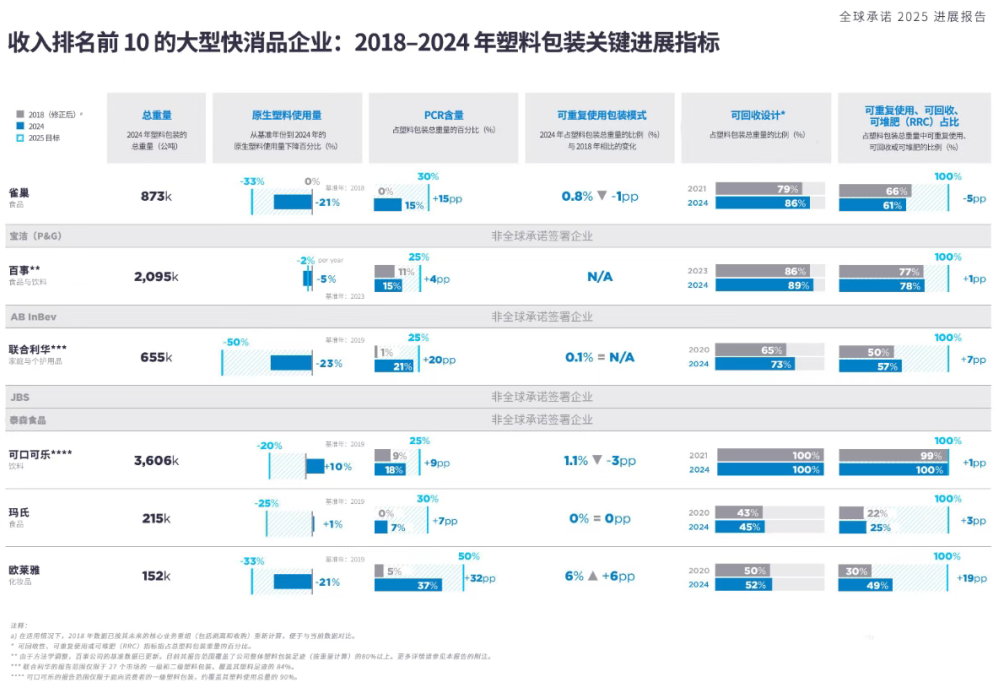
Top 10 Large FMCG Companies by Revenue: Key Progress Indicators for Plastic Packaging from 2018 to 2024
Nestlé (Food sector): In 2024, the total weight of plastic packaging is 873,000 tons, with the use of virgin plastics decreasing by 21% compared to the baseline year (2018), PCR content reaching 15%, an increase of 15 percentage points; in terms of recyclable design, the proportion will be 86% in 2024.
PepsiCo (Food and Beverage Sector): Total Weight of Plastic Packaging in 2024The usage of virgin plastics is 2.095 million tons, a 5% reduction compared to the baseline year (2023). The PCR content accounts for 15%, an increase of 4 percentage points from before. In terms of recyclable design, the proportion will reach 89% in 2024.
Unilever (Home and Personal Care sector): In 2024, the total weight of plastic packaging is 655,000 tons, with the use of virgin plastic reduced by 23% compared to the baseline year (2019), and the proportion of PCR content at 21%, an increase of 20 percentage points; the design for recyclability rate will reach 73% in 2024.
Coca-Cola (in the beverage sector): In 2024, the total weight of plastic packaging is 3.606 million tons, with the use of virgin plastic increasing by 10% compared to the baseline year (2019). The proportion of PCR content is 18%, an increase of 9 percentage points; the design for recyclability will remain at 100% in 2024.
Mars (Food Sector): Total plastic packaging weight in 2024 is 215,000 tons, with a 1% increase in virgin plastic usage compared to the baseline year (2019). PCR content accounts for 7%, an increase of 7 percentage points; recyclable design accounts for 45% in 2024.
L'Oréal (Cosmetics sector): In 2024, the total weight of plastic packaging is 152,000 tons, with the use of virgin plastic reduced by 21% compared to the baseline year (2019). The percentage of PCR content is 37%, an increase of 32 percentage points; the proportion of reusable packaging models is 6%; the proportion of recyclable design in 2024 is 52%.
Key Progress Indicators for Plastic Packaging 2018-2024
In "Other Major FMCG Companies by Revenue: Key Progress Indicators for Plastic Packaging from 2018 to 2024," several companies have made respective progress in sustainable development of plastic packaging.
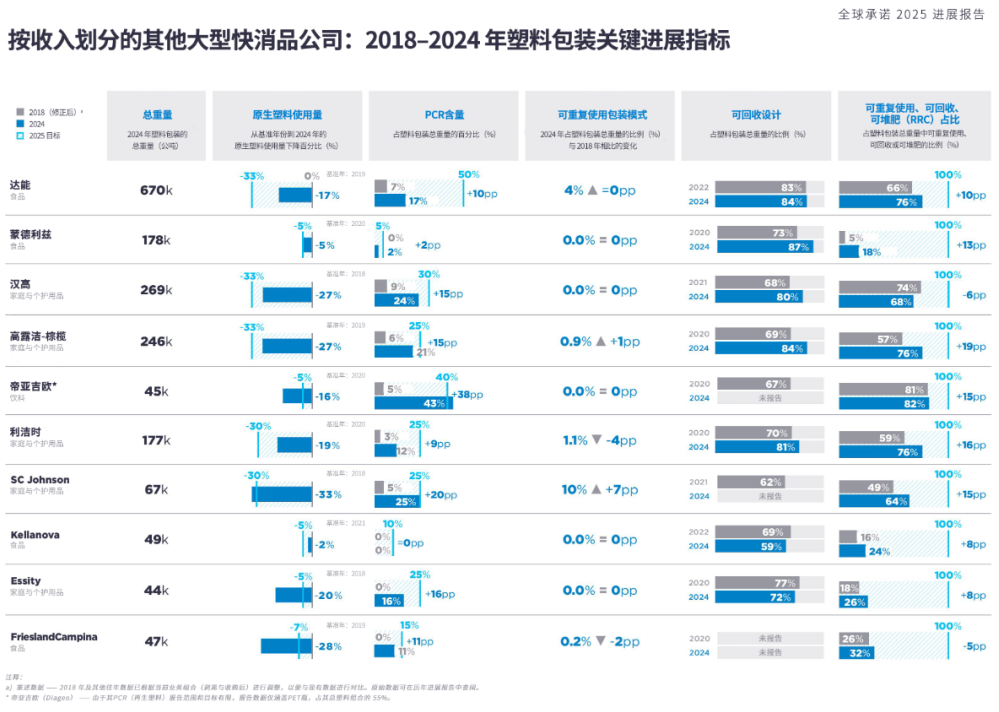
Chart: Key Progress Indicators for Plastic Packaging of Other Major FMCG Companies by Revenue: 2018-2024
Danone (in the food sector): Total plastic packaging weight of 670,000 tons in 2024, a 17% reduction in virgin plastic usage compared to the baseline year (2019), PCR content accounting for 17%, an increase of 10 percentage points; reusable packaging models accounting for 4%; recyclable design accounting for 84% in 2024.
Mondelez (Food Sector): Total weight of plastic packaging in 2024 is 178,000 tons, with a 5% reduction in virgin plastic usage compared to the baseline year (2020), PCR content accounting for 2%, an increase of 2 percentage points; recyclable design will account for 87% in 2024.
Henkel (Home & Personal Care sector): Total plastic packaging weight in 2024 is 269,000 tons, with a 27% reduction in virgin plastic usage compared to the baseline year (2018), PCR content accounts for 24%, an increase of 15 percentage points; recyclable design accounts for 80% in 2024.
Colgate-Palmolive (Household and Personal Care sector): In 2024, the total weight of plastic packaging is 246,000 tons, with a 27% reduction in the use of virgin plastic compared to the baseline year (2019). The proportion of PCR (Post-Consumer Recycled) content is 21%, an increase of 15 percentage points; designs that are recyclable and sustainable account for 84% in 2024.
Diageo (Beverage sector): Total weight of plastic packaging in 2024 is 45,000 tons, with a 16% reduction in the use of virgin plastic compared to the baseline year (2020). PCR content accounts for 43%, an increase of 38 percentage points.
Reckitt (Household and Personal Care Sector): In 2024, the total weight of plastic packaging will be 177,000 tons, with a 19% reduction in the use of virgin plastic compared to the baseline year (2020). The proportion of PCR content will be 12%, an increase of 9 percentage points. The design for recyclability will account for 81% in 2024.
SC Johnson (Home and Personal Care Sector): In 2024, the total weight of plastic packaging will be 67,000 tons, with a 33% reduction in virgin plastic usage compared to the baseline year (2018). PCR content will account for 25%, an increase of 20 percentage points; the proportion of reusable packaging models will be 10%, an increase of 7 percentage points.
Kellanova (in the food sector): The total weight of plastic packaging in 2024 is 49,000 tons, with a 2% reduction in the use of virgin plastic compared to the baseline year (2021), a 0% share of PCR content, and 59% of the design being recyclable in 2024.
Essity (in the field of household and personal products): The total weight of plastic packaging in 2024 is 44,000 tons, with a 20% reduction in the use of virgin plastic compared to the baseline year (2018). The proportion of PCR content is 16%, an increase of 16 percentage points. The design for recyclability will account for 72% in 2024.
FrieslandCampina (in the food sector): The total weight of plastic packaging in 2024 is 47,000 tons. The use of virgin plastic decreased by 28% compared to the baseline year (2019), with a PCR content proportion of 11%, an increase of 11 percentage points.
【Copyright and Disclaimer】The above information is collected and organized by PlastMatch. The copyright belongs to the original author. This article is reprinted for the purpose of providing more information, and it does not imply that PlastMatch endorses the views expressed in the article or guarantees its accuracy. If there are any errors in the source attribution or if your legitimate rights have been infringed, please contact us, and we will promptly correct or remove the content. If other media, websites, or individuals use the aforementioned content, they must clearly indicate the original source and origin of the work and assume legal responsibility on their own.
Most Popular
-
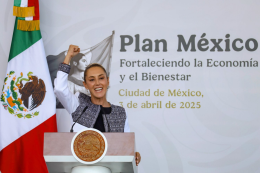
Mexico officially imposes tariffs on 1,400 chinese products, with rates up to 50%
-

List Released! Mexico Announces 50% Tariff On 1,371 China Product Categories
-

Progress on plastic reduction in packaging released by 16 fast-moving consumer goods brands including nestlé, pepsi, unilever, coca-cola, and mars
-

Brazil Imposes Five-Year Anti-Dumping Duty of Up to $1,267.74 Per Ton on Titanium Dioxide From China
-

Significant Data Gaps in Plastic Additive Safety! Cheap Catalyst with Air Enables Efficient PET Decomposition






